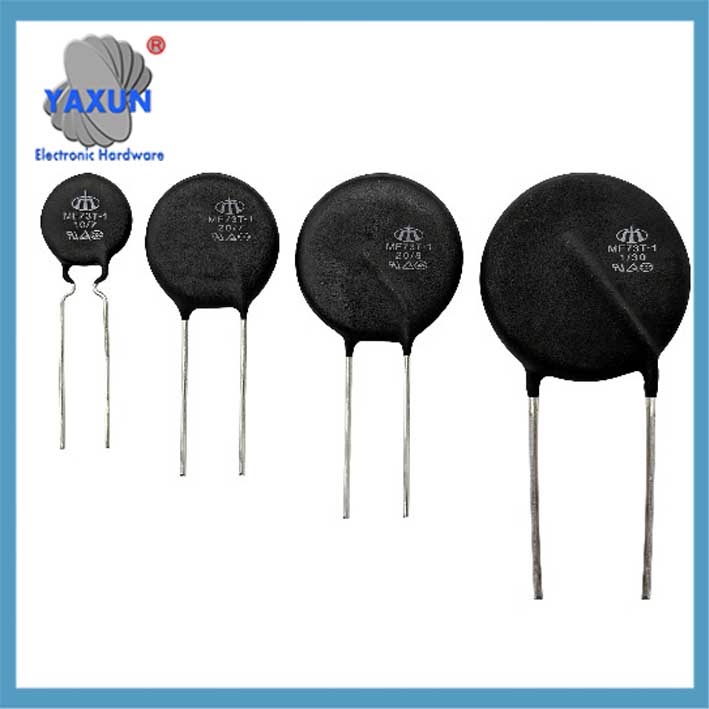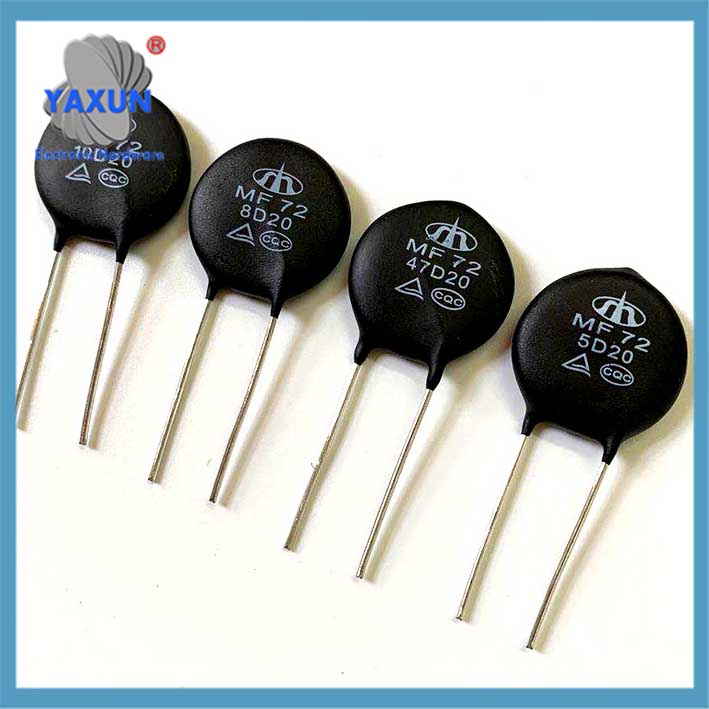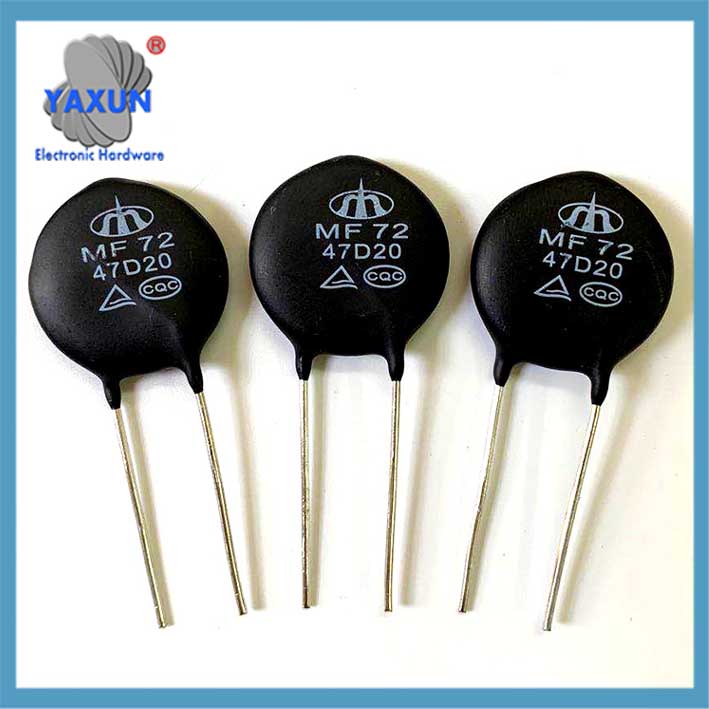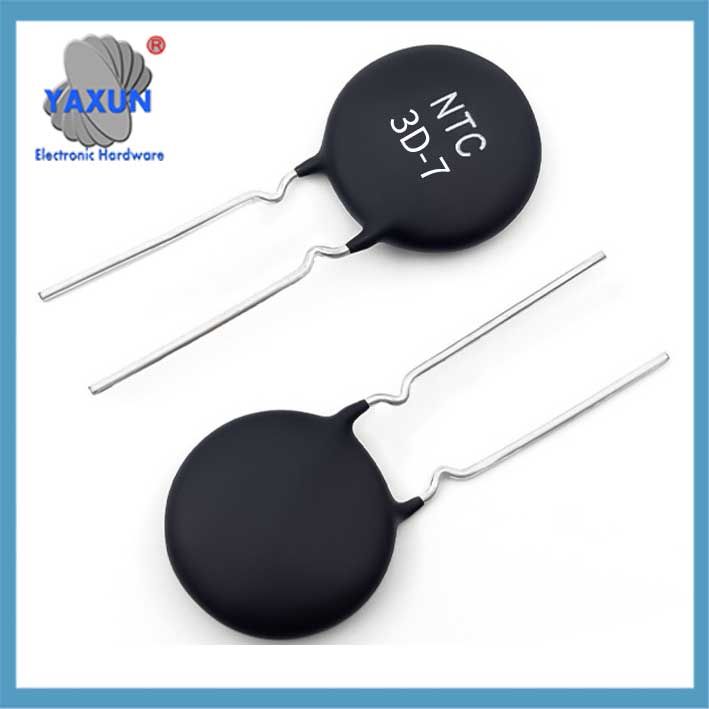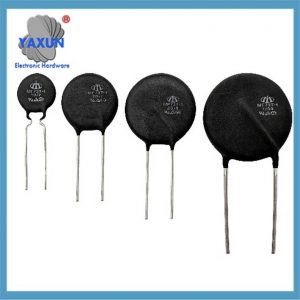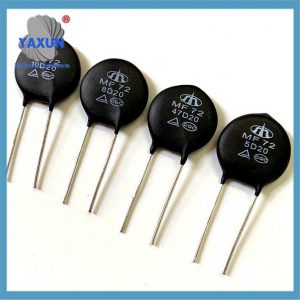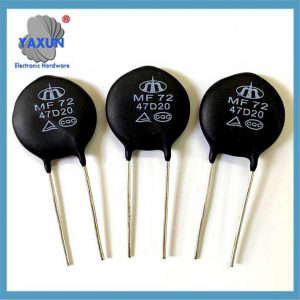Categorías de Producto
- fusible térmico 32
- fusibles de montaje en superficie 12
- termistor 36
- Portafusibles de montaje en PCB 27
- Arnés de cableado 6
- Portafusibles de cuchilla 17
- termostato 50
- Fusible eléctrico 24
- Sensor de temperatura automotriz 7
- Disyuntor térmico 22
- Portafusibles 36
- Sensor de temperatura 75
- Interruptor térmico 68
- Fusible del coche 20
- Fusibles atornillados 8
Etiquetas de productos
Aplicación y selección de termistores de potencia
¿Qué es un termistor de potencia?? Un termistor de potencia, También conocido como Power NTC o Limitador de corriente de INRUSH, es un componente diseñado para suprimir las corrientes de entrada en los circuitos eléctricos. Utiliza la característica de autocalación de un coeficiente de temperatura negativa (CNT) termistor para limitar las altas corrientes que pueden aumentar cuando se enciende un circuito.
Termistor de potencia (Coeficiente de temperatura principalmente negativo tipo NTC) Es un componente clave para suprimir sobretensiones en circuitos electrónicos.. Sus principales parámetros, Los puntos de selección y los escenarios de aplicación son los siguientes.:
I. Funciones y principios básicos
Supresión de sobretensión
En el momento del encendido, el valor de resistencia NTC conectado en serie en el circuito de entrada es alto, que puede limitar la corriente máxima; después de encender la energía, la resistencia cae rápidamente debido al calor (El consumo de energía se puede ignorar.), Asegurar el funcionamiento estable de los circuitos posteriores..
Características de temperatura negativas
El valor de resistencia disminuye exponencialmente al aumentar la temperatura.: R(t)=R0⋅eB⋅(1T-1T0)R(t)=R0⋅eB⋅(T1-T01) (R0R0 es el valor de resistencia a 25 ℃, BB es la constante del material).
Cómo funciona:
Alta resistencia inicial:
Cuando se aplica la energía por primera vez, un termistor de potencia tiene una alta resistencia, que limita la corriente de irrupción inicial.
Autocalentamiento:
A medida que la corriente fluye a través del termistor, genera calor, haciendo que su resistencia disminuya.
Disminución de la resistencia:
La reducción de la resistencia permite que el circuito extraiga la corriente operativa necesaria sin la sobretensión inicial..
Beneficios:
Protege el equipo:
Limitando la corriente de entrada, Los termostatos eléctricos evitan daños a componentes y equipos sensibles..
Reduce la pérdida de energía:
La disminución de la resistencia mediante el autocalentamiento reduce la pérdida de potencia en comparación con el uso de una resistencia fija..
Ahorro de energía:
Reducir la pérdida de energía puede generar ahorros de energía en aplicaciones como cambiar fuentes de alimentación y otros dispositivos eléctricos..
II. Parámetros clave y puntos de selección.
| Parámetros | Significado de la definición y la selección. | Valor/rango típico |
| Resistencia nominal de potencia cero (R25) | La resistencia nominal a 5°C determina la capacidad inicial de supresión de sobretensiones.. Fórmula de cálculo: R25≈U2⋅IsurgeR25≈2⋅IsurgeU (UU es el voltaje de entrada, IsurgeIsurge es la corriente de sobretensión) | 2,5 Ω de uso común, 5Oh, 10Ω±(15-30)% |
| Corriente máxima en estado estacionario | La corriente que puede mantenerse durante mucho tiempo a 25 ℃, debe ser mayor que la corriente de trabajo del circuito | Dependiendo del modelo 0,5A~decenas de amperios |
| Resistencia residual | El valor mínimo de resistencia a alta temperatura. (como 100 ℃), afectando el consumo normal de energía del circuito | Aproximadamente 1/10~1/20 de R25 |
| Valor b | Constante material (medido a 25 ℃ ~ 50 ℃), determina la pendiente de la curva resistencia-temperatura; El valor B alto responde rápidamente pero tiene un costo alto. | 2000K~6000K |
| Constante de tiempo térmico | Índice de velocidad de respuesta, tipo de parche (como SMD) puede llegar a segundos | Sello de vidrio/tipo alambre esmaltado aproximadamente 10~60 segundos |
Nota: Ejemplo de identificación del modelo MF72-10D-9:
10: R25=10Ω.
D: Paquete de discos
9: 9mm de diámetro;
III. Escenarios de aplicación típicos
Equipo de suministro de energía: Supresión de sobretensiones de entrada de la fuente de alimentación conmutada, Unión Postal Universal, adaptador;
Sistema de iluminación: Protección antichoque del controlador LED, lastre, caja de distribución de iluminación;
Equipo industrial: Arranque del motor, fuente de alimentación industrial, instrumento medico;
Electrodomésticos: Acondicionador de aire, protección de arranque del compresor del refrigerador;
IV. Guía de selección y evitación.
Coincidencia actual
La corriente máxima en estado estacionario debe ser mayor que 1.5 veces la corriente de trabajo real para evitar el calentamiento continuo y fallas.
Diseño de disipación de calor
En escenarios de alta potencia, Se requiere espacio suficiente o disipación de calor auxiliar para evitar que un aumento excesivo de temperatura cause una resistencia residual insuficiente..
Temperatura extrema
El rango de temperatura de funcionamiento es generalmente de -55 ℃ ~ +125 ℃. Modelos sellados con vidrio (resistente a 150 ℃) Se prefieren en ambientes de alta temperatura..
V. Comparación de paquetes y rendimiento
| Tipo de paquete |
Ventajas | Escenarios aplicables |
| Resina epoxídica | Bajo costo, buena impermeabilidad | electrodomésticos, fuentes de alimentación ordinarias |
| paquete de vidrio | Resistencia a altas temperaturas (> 150 ℃), respuesta rápida | Equipos industriales, electrónica automotriz |
| Tipo de montaje en superficie (SMD) | Talla pequeña, adecuado para PCB de alta densidad | Módulo de potencia compacto |
Consejo: Tenga cuidado en escenarios de cambios frecuentes – NTC puede perder la capacidad de supresión de sobretensiones cuando el enfriamiento insuficiente es insuficiente. En este momento, se puede conectar un bypass de relé paralelo.
Contáctenos
Esperando tu email, le responderemos dentro de 12 horas con la valiosa información que necesitabas.
 English
English Afrikaans
Afrikaans العربية
العربية বাংলা
বাংলা bosanski jezik
bosanski jezik Български
Български Català
Català 粤语
粤语 中文(简体)
中文(简体) 中文(漢字)
中文(漢字) Hrvatski
Hrvatski Čeština
Čeština Nederlands
Nederlands Eesti keel
Eesti keel Suomi
Suomi Français
Français Deutsch
Deutsch Ελληνικά
Ελληνικά हिन्दी; हिंदी
हिन्दी; हिंदी Magyar
Magyar Bahasa Indonesia
Bahasa Indonesia Italiano
Italiano 日本語
日本語 한국어
한국어 Latviešu valoda
Latviešu valoda Lietuvių kalba
Lietuvių kalba македонски јазик
македонски јазик Bahasa Melayu
Bahasa Melayu Norsk
Norsk پارسی
پارسی Polski
Polski Português
Português Română
Română Русский
Русский Cрпски језик
Cрпски језик Slovenčina
Slovenčina Slovenščina
Slovenščina Español
Español Svenska
Svenska ภาษาไทย
ภาษาไทย Türkçe
Türkçe Українська
Українська اردو
اردو Tiếng Việt
Tiếng Việt
